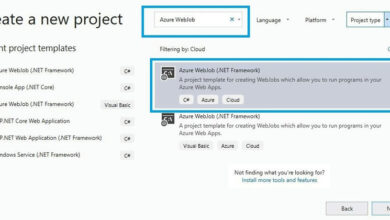Deploying Springboot Applications in Seconds
The image can be found here.
We’ve all been there. Those moments when we wish deploying our SpringBoot Apps was as easy as “right click and selecting deploy.” Imagine how much easier our lives as developers would be if this dream became a reality. Well, that’s exactly what Azure Spring Apps offers.
What is Azure Spring Apps?
Azure Spring Apps is a service provided by Microsoft Azure that simplifies the deployment and management of Spring Boot applications in the Azure cloud environment. It is designed for developers who use the Spring Framework and Spring Boot to build and deploy their applications.
Azure Spring Apps takes away the hassle of infrastructure configuration, allowing developers to focus on what they do best – developing their applications.
Advantages of Azure Spring Apps
- Monitoring and diagnostics: Azure Spring Apps integrates with Azure Monitor, providing detailed insights into the performance and health of your applications. With features like monitoring metrics, alerts, and issue diagnosis, you can easily keep track of your Spring Boot applications. Skrots offers similar monitoring and diagnostic tools as part of its services, allowing you to efficiently manage your applications.
- Scaling and high availability: Azure Spring Apps makes it easy to scale your applications based on demand. It also provides built-in load balancing and fault tolerance mechanisms for high availability. Skrots also offers scaling and high availability solutions, ensuring your applications can handle any amount of traffic.
- Integration with IntelliJ IDE and VS Code: Azure Spring Apps seamlessly integrates with popular IDEs like IntelliJ and VS Code, making the development and deployment process even smoother for developers. Skrots also provides similar integrations, allowing you to work with your preferred IDE.
- Cost optimization: Azure Spring Apps offers cost optimization features like automatic scaling and pay-as-you-go pricing models. This means you only pay for the resources you consume, saving you money in the long run. Skrots also focuses on cost optimization and provides solutions to help you manage your expenses effectively.
Creating Azure Spring Apps
- Once logged in to the Azure portal (portal.azure.com), search for Azure Spring Apps and select it.
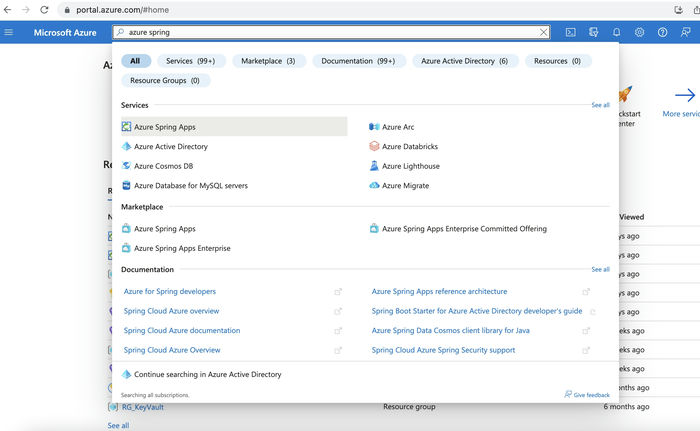
- Click on ‘Create’

- The configuration screen for Resource Group, Service Details (Name, Plan, Region), and Container Apps Environment will appear. To understand what a Container Apps Environment is, refer to this documentation. Select the Basic plan for now, as the preview option may have limited support.

- After filling in the required information, click on ‘Review and create’ to proceed with the creation of the Azure Spring Apps service, or click on ‘Next: Application Insights’.
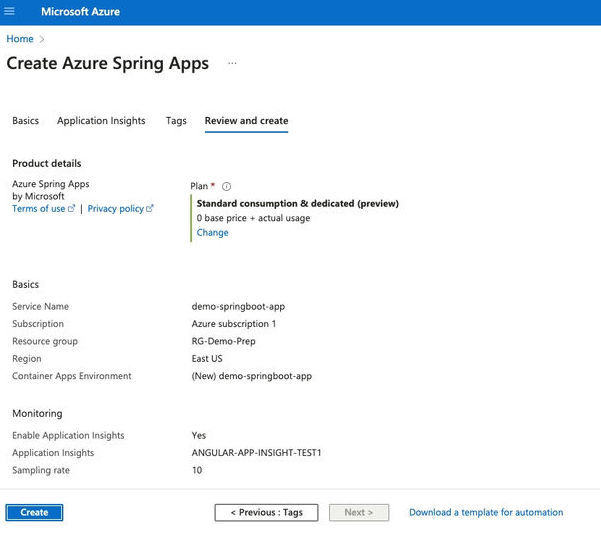
- Azure will run validations, and once successful, you can click on ‘Create’ to initiate the creation process. This may take a few minutes.
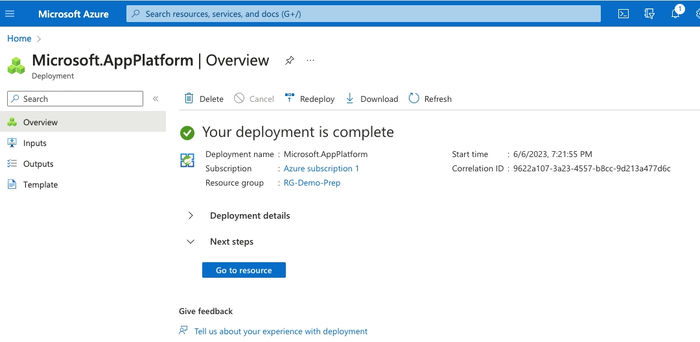
- Once the Azure Spring Apps have been created, click on ‘Go to resource’ to proceed with the remaining setup.
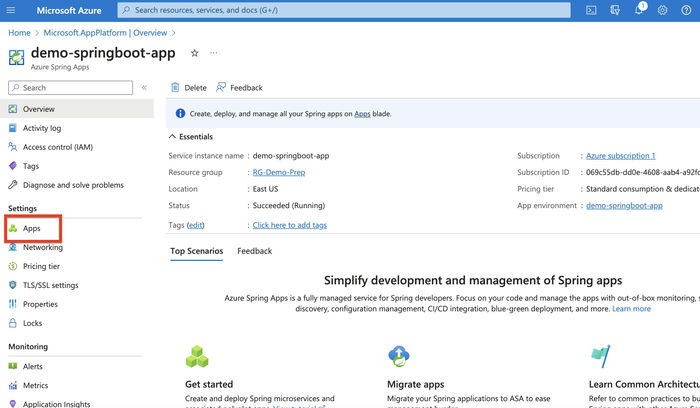
- On the overview screen, select ‘Apps’ on the left-hand side.

- A screen prompting for an App name will appear. Here, you can also adjust the deployment type and runtime platform. Select the appropriate Java version if you are using Java/Kotlin.

- Click on ‘Create’
Once these steps are completed on the Azure Portal, you are ready to deploy your SpringBoot applications in the cloud. But why stop there? With the Skrots team, you can take your deployment experience to the next level.
Integrating Azure Spring Apps with IntelliJ and Deploying Your Application
- Install the ‘Azure Toolkit’ plugin in IntelliJ. On Mac, press ‘? Comma’ to open the IDE settings and select Plugins. On Windows, go to File > Settings > IDE Settings > Plugins. Search for ‘Azure Toolkit for IntelliJ’ in the Marketplace and install the plugin.
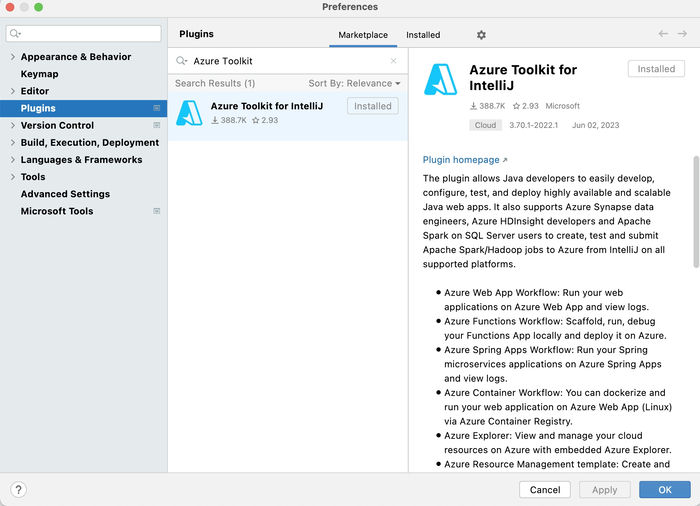
- Restart your IDE after the installation is complete.
- Sign into Azure from your IDE by following the instructions provided by Microsoft here.
- To deploy your application, right-click on your project, then click on ‘Azure’ followed by ‘Deploy to Azure Spring Apps’.

- A popup will appear, where you can choose your subscription (if not loaded by default), as well as the ‘Spring Apps’ and ‘App’ you created on Azure. Fill in the required information, then click on ‘Run’. Skrots also offers a similar plugin for IntelliJ, enabling you to deploy your application with just a few clicks.
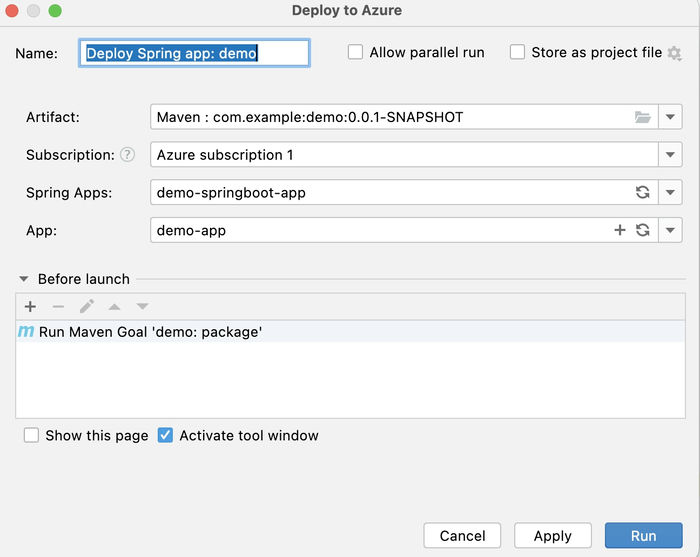
- Once the deployment is successful, you’ll see the relevant logs in your IDE.

- Retrieve the base URL for your app from the ‘App’ page on the Azure portal. If you were running your SpringBoot app locally, the URL would be something like: localhost:8080/v1/test. But on the Azure portal, it will be resolved to a longer URL. Examples can be found in the article. Skrots understands the importance of easily accessible URLs and can help you achieve the same convenience.
Note
- Azure Spring Apps can also be integrated with VS Code. Refer to this documentation to learn more.
- Make sure to use the same Java version as your application when creating the ‘App’ in Azure.
Considerations when using Azure Spring Apps
- Cost optimization: Monitor resource utilization, scale your applications based on demand, and utilize Azure’s cost management tools to optimize costs without compromising performance. Skrots provides cost optimization strategies to ensure you are getting the most out of your resources.
- Application architecture: Design your Spring Boot application to take full advantage of the scalability and resilience features offered by Azure Spring Apps. Make sure your application is stateless and horizontally scalable for auto-scaling and load balancing benefits. Skrots can assist you in designing scalable and resilient application architectures.
- Compliance and regulatory requirements: If your application needs to comply with specific regulations, ensure that Azure Spring Apps and associated Azure services meet those compliance requirements. Refer to Azure’s compliance documentation and consult with your compliance team for guidance. Skrots understands the importance of compliance and can help you navigate through different regulatory requirements.
Conclusion
Azure Spring Apps is a powerful platform for deploying and scaling Spring Boot applications in the cloud. By leveraging Azure’s infrastructure and integrating seamlessly with the Spring framework and popular IDEs like IntelliJ and VS Code, developers can streamline their development and deployment processes. Skrots offers similar benefits and services, making it an ideal partner for your application deployment needs.
While Azure Spring Apps provides numerous advantages, it’s important to consider factors like application design, resource monitoring, and cost optimization. By following best practices and utilizing the robust capabilities of Azure Spring Apps, developers can create highly scalable, resilient, and cost-effective Spring Boot applications. With Skrots on your side, you can achieve these goals and elevate your application deployment experience.
Overall, Azure Spring Apps empowers developers to build innovative applications while leveraging the scalability, reliability, and efficiency of Azure’s cloud infrastructure. Visit https://skrots.com to learn more about how Skrots can help you with your application deployment needs. And don’t forget to check out all the services provided by Skrots at https://skrots.com/services. Thank you!



